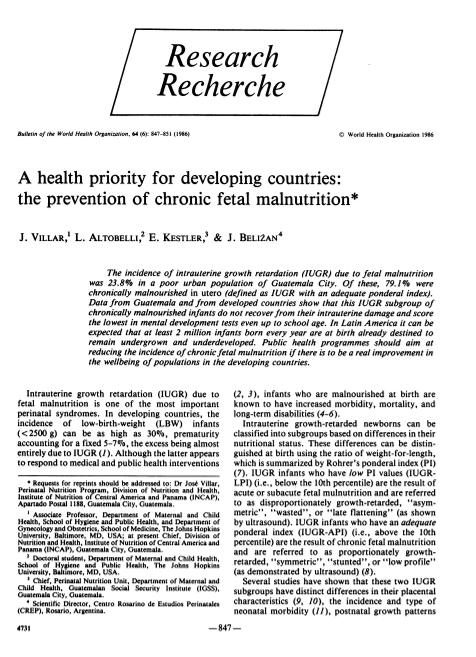Mostrar el registro sencillo del ítem
dc.contributor.author
Villar, J.
dc.contributor.author
Altobelli, L.
dc.contributor.author
Kestler, Edgar
dc.contributor.author
Belizan, Jose

dc.date.available
2024-03-22T11:52:51Z
dc.date.issued
2021-02
dc.identifier.citation
Villar, J.; Altobelli, L.; Kestler, Edgar; Belizan, Jose; A health priority for developing countries: the prevention of chronic fetal malnutrition; World Health Organization; Bulletin of the World Health Organization; 64; 6; 2-2021; 847-851
dc.identifier.issn
0042-9686
dc.identifier.uri
http://hdl.handle.net/11336/231286
dc.description.abstract
A prospective study of 3557 consecutively born neonates from a lower middle class district in Guatemala City documented a 23.8% incidence of intrauterine growth retardation due to fetal malnutrition. Those infants whose weights are below the 10th percentile of a sex- and race-specific birthweight and gestational age distribution, based on a developed country population, were considered to manifest intrauterine growth retardation. Ponderal index values were then used to further classify this population as having chronic fetal malnutrition (above the 10th percentile of the standard distribution) or subacute fetal malnutrition (below the 10th percentile); the incidences of these conditions were 79.1% and 20.8%, respectively. The results of numerous studies carried out in various populations suggest that developing countries have a higher incidence of chronically malnourished infants within the intrauterine growth retardation population, while subacute fetal malnutrition is more prevalent in developed countries. Moreover, it has been shown that chronically malnourished infants do not recover from their intrauterine damage and score the lowest in mental development tests even up to school age. They remain lighter, shorter, and with a smaller head circumference until at least 3 years of age. Based on the incidence rates ascertained in this study, it can be estimated that at least 2 million infants born each year in Latin America are at risk of chronic intrauterine growth retardation. Screening programs are needed to identify at-risk mothers early in pregnancy so that medical and nutritional interventions can be implemented.
dc.format
application/pdf
dc.language.iso
eng
dc.publisher
World Health Organization

dc.rights
info:eu-repo/semantics/openAccess
dc.rights.uri
https://creativecommons.org/licenses/by-nc-sa/2.5/ar/
dc.subject
PREVENTION
dc.subject
CHRONIC FETAL MALNUTRITION
dc.subject
NUTRITION
dc.subject.classification
Otras Ciencias de la Salud

dc.subject.classification
Ciencias de la Salud

dc.subject.classification
CIENCIAS MÉDICAS Y DE LA SALUD

dc.title
A health priority for developing countries: the prevention of chronic fetal malnutrition
dc.type
info:eu-repo/semantics/article
dc.type
info:ar-repo/semantics/artículo
dc.type
info:eu-repo/semantics/publishedVersion
dc.date.updated
2022-04-21T16:24:08Z
dc.journal.volume
64
dc.journal.number
6
dc.journal.pagination
847-851
dc.journal.pais
Suiza

dc.journal.ciudad
Ginebra
dc.description.fil
Fil: Villar, J.. University Johns Hopkins; Estados Unidos
dc.description.fil
Fil: Altobelli, L.. University Johns Hopkins; Estados Unidos
dc.description.fil
Fil: Kestler, Edgar. Institute Of Nutrition Of Central America And Panama Guatemala; Guatemala
dc.description.fil
Fil: Belizan, Jose. Centro Rosarino de Estudios Perinatales; Argentina. Instituto de Efectividad Clínica y Sanitaria; Argentina. Consejo Nacional de Investigaciones Científicas y Técnicas. Oficina de Coordinación Administrativa Parque Centenario. Centro de Investigaciones en Epidemiología y Salud Pública. Instituto de Efectividad Clínica y Sanitaria. Centro de Investigaciones en Epidemiología y Salud Pública; Argentina
dc.journal.title
Bulletin of the World Health Organization

dc.relation.alternativeid
info:eu-repo/semantics/altIdentifier/url/https://www.ncbi.nlm.nih.gov/pmc/articles/PMC2490987/
Archivos asociados
